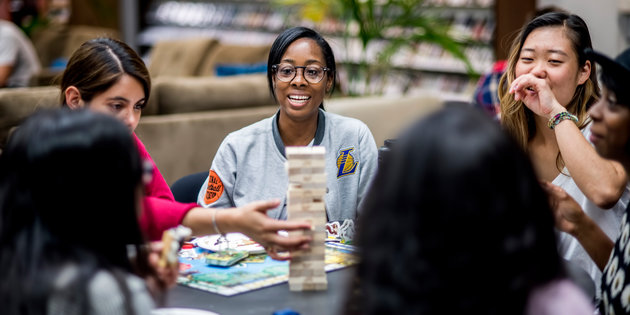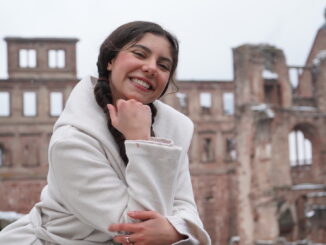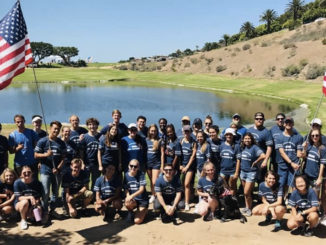
Diversity.
So tangible, yet so difficult to grasp.
Universities are constantly working toward greater diversity in the student body and in the faculty because it enhances academic discussion, promotes experiential learning and equips students to become future leaders in the global economy.
And for Pepperdine University, it is essential to its Christian mission.
“Seaver works toward diversity because it is a critical component of living fully our faith mission,” Director of Admissions Laura Kalinkewicz said. “(We’re) achieving educational excellence by fostering an environment where students will be exposed to and challenged by unique perspectives, and (by) fostering skills necessary to succeed in and improve the global, knowledge-based marketplace.”
Pepperdine’s leadership has actively worked toward increasing diversity on campus — successfully in the student body and less successfully among the faculty. Admissions officers have worked to promote diversity by increasing their recruitment net and increasing financial aid. Student life administrators promote diversity through cultural club fairs and events, as well as encouraging students to spend time abroad.
“I believe that a diverse student body offers an enriched learning opportunity for all students,” President Andrew K. Benton said. “When I meet with students, I enjoy the different points of view and the breadth of perspectives that divergent experiences and backgrounds often provide.”
However, not everyone feels that away.
When Pepperdine Graphic Assistant News Editor Falon Opsahl wrote an article about Pepperdine reaching 50 percent minorities in the student population, sophomore Justin Dunn wrote a Letter to the Editor saying that his “educational value at Pepperdine is plummeting.” Dunn represents a national voice that perceives active recruitment of minority students as a form of affirmative action that reduces the overall quality of the student body.
In undergraduate admissions, diversity plays a prominent role in recruiting and selection, Kalinkewicz said.
“In Seaver admissions, our counselors are mindful of racial, ethnic, gender, geographic and disciplinary diversity when choosing which high schools to visit,” Kalinkewicz said. “More public, institutional commitments to fostering diverse leadership, such as the Posse Foundation partnership, help students feel a sense that diversity is celebrated and Seaver promotes a welcoming environment.”
Pepperdine administrators said they believe diversity is a crucial component in providing the best educational experience for their students. It is important for Pepperdine’s mission statement and heritage.
Provost Daryl Tippens, the chief academic officer of Pepperdine, said the university’s strategic plan and charter of the University Diversity Council outline Pepperdine’s strategy to work toward making the campus more diverse.
Pepperdine University created a strategic plan in 2010 titled, “Boundless Horizons” that defined the goals the university has set to work toward in the coming decade.
In the plan, Benton identified five primary goals: advancing learning knowledge and scholarship; developing resources; building community; respecting diversity and promoting global understanding, and honoring God and heritage. He said he intends for Pepperdine University to be a contemporary expression of a global, intellectual community.
In addition, Pepperdine’s Diversity Council wrote a charter in 2006 addressing the idea that the university takes great care in making the institution more diverse because it is essential to the health of our institution and it is part of the university’s Christian heritage to love justice and to treat others equally.
Pepperdine has clearly succeeded at increasing the diversity of the student body.
The total number of students who attended Seaver College in 2007 was 3,398 students, according to the Pepperdine University Fact Book. Nearly 60 percent of the student body (2,004 students) was white, and almost 40 percent (1,394 students) were minorities.
As of fall 2013, 3,538 students currently attend Seaver College, according to the Pepperdine University Fact Book. Nearly 40 percent of the population, or 1,497 students, is represented by white Americans, and almost 60 percent is made up of 2,041 minority students. In a six-year period, Pepperdine has increased its minority population by 20 percentage points.
However, the diversity of Pepperdine’s faculty is a different story.
Today, nearly 90 percent of the entire faculty population is white, according to the Pepperdine University Fact Book. The rest of the staff is of Asian, Hispanic, black or “other” descent.
“We have similar initiatives to increase our diversity among students and faculty,” Dean of Seaver College Rick Marrs said. “One challenge we have at the faculty level is that, whereas students rotate through on a four-year cycle, faculty often have 25-30 year careers at our institution, and so it is more difficulty to change the diverse percentages quickly.”
Marrs said Pepperdine normally only hires when there is an opening through a retirement or a person leaving the university. Therefore, he said it is much harder to increase diversity within the faculty than it is in the student population.
On campus, students share their culture with other students on campus through a distinct array of cultural clubs such as the Korean Student Association (KSA), Black Student Association and Latino Student Association (LSA).
“In LSA, we participate in cultural events such as the Mexican holiday ‘Dia de los Muertos’ (Day of the Dead) by collaborating with the cooking class by creating pan dulces and other traditional specialties,” LSA member Jessica Villeda said.
In 2011, the Institute of International Education ranked Pepperdine University No. 2 for the highest number of students who study abroad and for the highest number of students who study abroad for the full year. Students have the opportunity to study abroad in six foreign countries and the nation’s capital during the academic year, exposing students to the rich abundance of cultures that exist outside of Malibu.
Students at Pepperdine have different opinions on diversity. Some agree that diversity has helped stimulate their education, while others such as Dunn are not fond of the way diversity works in universities.
Dunn, who is white, said he believes that opportunities should be earned, not given. He feels that he continually has to prove himself to various Pepperdine committees, such as admissions, much more than other students because of the complexion of his skin.
However, Dunn said he believes diversity can be beneficial. He argues that the characteristics that make someone a valuable person should not be determined by the color of their skin, but rather by the beliefs, actions and approach to life.
Many other students said they truly enjoy diversity at Pepperdine and that it helps them feel at home.
“Coming from a school not as diverse, I really appreciate the diversity here on campus and the different perspectives that our class has to offer to each other,” freshman Marjorie Jones said.
Jones is from Birmingham, Alabama and she said she enjoys being able to meet people from different cultures and gain different insights from her peers.
“I have seen a big difference within the two years,” junior Claudia Lin said. “I think diversity is important and it’s nice to have a spectrum of cultures here on a college campus.”
Pepperdine administrators said they are proud of the accomplishments Pepperdine has made so far in regard to diversity and are optimistic about the coming years and how much will be accomplished.
“I would say that virtually every unit of the university, academic and nonacademic, includes aspects of these goals in their policies and practices,” Tippens said.
Benton agreed with Tippens, and said Pepperdine has so far been quite successful in working toward becoming a more diverse university.
“Frankly, I don’t perceive struggles as much as I observe that our success has been a matter of determination,” Benton said. “I am proud of the progress we have made over the past several years.”
Elizabeth Villagomez completed this story in Dr. Christina Littlefield’s fall 2013 Jour 241 class.



